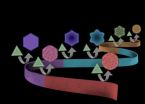(Press-News.org) CAMBRIDGE, MA -- The brain has billions of neurons, arranged in complex circuits that allow us to perceive the world, control our movements and make decisions. Deciphering those circuits is critical to understanding how the brain works and what goes wrong in neurological disorders.
MIT neuroscientists have now taken a major step toward that goal. In a new paper appearing in the Aug. 9 issue of Nature, they report that two major classes of brain cells repress neural activity in specific mathematical ways: One type subtracts from overall activation, while the other divides it.
"These are very simple but profound computations," says Mriganka Sur, the Paul E. Newton Professor of Neuroscience and senior author of the Nature paper. "The major challenge for neuroscience is to conceptualize massive amounts of data into a framework that can be put into the language of computation. It had been a mystery how these different cell types achieve that."
The findings could help scientists learn more about diseases thought to be caused by imbalances in brain inhibition and excitation, including autism, schizophrenia and bipolar disorder.
Lead authors of the paper are grad student Caroline Runyan and postdoc Nathan Wilson. Forea Wang '11, who contributed to the work as an MIT undergraduate, is also an author of the paper.
A fine balance
There are hundreds of different types of neuron in the brain; most are excitatory, while a smaller fraction are inhibitory. All sensory processing and cognitive function arises from the delicate balance between these two influences. Imbalances in excitation and inhibition have been associated with schizophrenia and autism.
"There is growing evidence that alterations in excitation and inhibition are at the core of many subsets of neuropsychiatric disorders," says Sur, who is also the director of the Simons Center for the Social Brain at MIT. "It makes sense, because these are not disorders in the fundamental way in which the brain is built. They're subtle disorders in brain circuitry and they affect very specific brain systems, such as the social brain."
In the new Nature study, the researchers investigated the two major classes of inhibitory neurons. One, known as parvalbumin-expressing (PV) interneurons, targets neurons' cell bodies. The other, known as somatostatin-expressing (SOM) interneurons, targets dendrites — small, branching projections of other neurons. Both PV and SOM cells inhibit a type of neuron known as pyramidal cells.
To study how these neurons exert their influence, the researchers had to develop a way to specifically activate PV or SOM neurons, then observe the reactions of the target pyramidal cells, all in the living brain.
First, the researchers genetically programmed either PV or SOM cells in mice to produce a light-sensitive protein called channelrhodopsin. When embedded in neurons' cell membranes, channelrhodopsin controls the flow of ions in and out of the neurons, altering their electrical activity. This allows the researchers to stimulate the neurons by shining light on them.
The team combined this with calcium imaging inside the target pyramidal cells. Calcium levels reflect a cell's electrical activity, allowing the researchers to determine how much activity was repressed by the inhibitory cells.
"Up until maybe three years ago, you could only just blindly record from whatever cell you ran into in the brain, but now we can actually target our recording and our manipulation to well-defined cell classes," Runyan says.
Taking a circuit apart
In this study, the researchers wanted to see how activation of these inhibitory neurons would influence how the brain processes visual input — in this case, horizontal, vertical or tilted bars. When such a stimulus is presented, individual cells in the eye respond to points of light, then convey that information to the thalamus, which relays it to the visual cortex. The information stays spatially encoded as it travels through the brain, so a horizontal bar will activate corresponding rows of cells in the brain.
Those cells also receive inhibitory signals, which help to fine-tune their response and prevent overstimulation. The MIT team found that these inhibitory signals have two distinct effects: Inhibition by SOM neurons subtracts from the total amount of activity in the target cells, while inhibition by PV neurons divides the total amount of activity in the target cells.
"Now that we finally have the technology to take the circuit apart, we can see what each of the components do, and we found that there may be a profound logic to how these networks are naturally designed," Wilson says.
These two types of inhibition also have different effects on the range of cell responses. Every sensory neuron responds only to a particular subset of stimuli, such as a range of brightness or a location. When activity is divided by PV inhibition, the target cell still responds to the same range of inputs. However, with subtraction by SOM inhibition, the range of inputs to which cells will respond becomes narrower, making the cell more selective.
Increased inhibition by PV neurons also changes a trait known as the response gain — a measurement of how much cells respond to changes in contrast. Inhibition by SOM neurons does not alter the response gain.
The researchers believe this type of circuit is likely repeated throughout the brain and is involved in other types of sensory perception, as well as higher cognitive functions.
Sur's lab now plans to study the role of PV and SOM inhibitory neurons in a mouse model of autism. These mice lack a gene called MeCP2, giving rise to Rett Syndrome, a rare disease that produces autism-like symptoms as well as other neurological and physical impairments. Using their new technology, the researchers plan to test the hypothesis that a lack of neuronal inhibition underlies the disease.
INFORMATION:
Written by Anne Trafton, MIT News Office
END
EAST LANSING, Mich. — Innovative problem solving requires trying many different solutions. That's true for humans, and now Michigan State University researchers show that it's true for hyenas, too.
The study, published in the current issue of the Proceedings of the Royal Society B, presented steel puzzle boxes with raw meat inside to wild spotted hyenas in Kenya. To get the meat, the hyenas had to slide open a bolt latch. Even though most of the animals had many opportunities to open the box, only nine out of 62 hyenas succeeded. The successful hyenas tried more solutions, ...
For more than 45 years, the poor in this country have been identified by the U.S. Census Bureau's Official Poverty Measure — a tool that determines America's poverty rate based on pretax money income, which does not reflect all the resources at a family's disposal.
That method of calculating who is poor and who is not has been under fire by researchers for years because it doesn't calculate the benefits of anti-poverty programs — such as food stamps and housing subsidies — into its formula. In response to the criticism, the Census Bureau released in fall 2011 the Supplemental ...
Bethesda, Md. (Aug. 8, 2012)—Adolescence is an important time not only for growing but for acquiring healthy habits that will last a lifetime, such as choosing foods rich in vitamins and minerals, and adopting a regular exercise regimen. Unfortunately, several studies have shown that adolescents' intake of important nutrients, as well as their performance on standard physical fitness tests, has fallen in recent years. Because nutrition and fitness are intertwined—for example, iron forms part of hemoglobin, which carries oxygen to muscles, and antioxidants such as vitamin ...
AURORA, Colo. – (Aug. 8. 2012) - A recent study by University of Colorado School of Medicine researchers shows that it is very common for adolescents in substance abuse treatment to use medical marijuana recommended to someone else (also known as "diverted" medical marijuana).
Stacy Salomonsen-Sautel, PhD, a postdoctoral fellow in the CU School of Medicine's Department of Pharmacology and her colleagues in the Department of Psychiatry looked at two adolescent substance abuse treatment programs in the Denver metropolitan area. The study participants were asked questions ...
CHAMPAIGN, Ill. — DNA holds the genetic code for all sorts of biological molecules and traits. But University of Illinois researchers have found that DNA's code can similarly shape metallic structures.
The team found that DNA segments can direct the shape of gold nanoparticles – tiny gold crystals that have many applications in medicine, electronics and catalysis. Led by Yi Lu, the Schenck Professor of Chemistry at the U. of I., the team published its surprising findings in the journal Angewandte Chemie.
"DNA-encoded nanoparticle synthesis can provide us a facile but ...
A bonus payment to teachers can improve student academic performance — but only when it is given upfront, on the condition that part of the money must be returned if student performance fails to improve, research at the University of Chicago shows.
The study showed that students gained as much as a 10 percentile increase in their scores compared to students with similar backgrounds — if their teacher received a bonus at the beginning of the year, with conditions attached. There was no gain for students when teachers were offered the bonus at the end of the school year, ...
Typhoon Haikui weakened to a tropical storm just before landfall in China. Eight hours after landfall, NASA's Aqua satellite still showed a strong and organized tropical storm moving inland.
China's National Meteorological Center (NMC) said that Tropical Storm Haikui, made landfall in Zhejiang province on August 8 at 3:20 a.m. local time (19:20 UTC or 3:20 p.m. EDT/U.S., August 7), about 140 miles (225 km) south of Shanghai. The Joint Typhoon Warning Center's last official warning on Haikui was issued on August 8 at 0300 UTC (11 a.m. local time/Shanghai). At that time ...
NASA's TRMM satellite has been measuring the heavy rainfall in Ernesto, and some of the rainfall totals may reach one foot in Central America. NASA's Aqua satellite spotted a large area of the strong thunderstorms generating that heavy rainfall, wrapped around the storm's center. Ernesto made landfall in the Yucatan and is currently tracking west over land.
At 11:15 p.m. EDT on Tuesday, August 7, Belize radar indicated Ernesto made landfall along the southern Yucatan coast near Mahahual, Mexico as a category one hurricane with maximum sustained winds near 85 mph (140 ...
GAINESVILLE, Fla. --- A new University of Florida study shows the turkey, one of the most widely consumed birds worldwide, was domesticated more than 1,000 years earlier than previously believed.
Researchers say discovery of the bones from an ancient Mayan archaeological site in Guatemala provides evidence of domestication, usually a significant mark of civilization, and the earliest evidence of the Mexican turkey in the Maya world. The study appears online in PLoS ONE today.
The discovery of the turkey bones is significant because the Maya did not use a lot of domesticated ...
Geckos are remarkable little creatures, clinging to almost any dry surface, and Alyssa Stark, from the University of Akron, USA, explains that they appear to be equally happy scampering through tropical rainforest canopies as they are in urban settings. 'A lot of work is done on geckos that looks at the very small adhesive structures on their toes to really understand how the system works at the most basic level', says Stark. She adds that the animals grip surfaces with microscopic hairs on the soles of their feet that make close enough contact to be attracted to the surface ...


